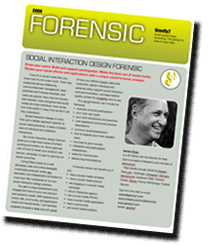
I recently had my first experience with a skype IM conference chat. This wasn't my first group chat, but it's been a while. IRC chats were so much faster! The chat started off as a group but I had to leave early on to attend to a meeting. When the meeting was over I checked back into the chat and it practically took me several minutes to catch up. By the following day the chat had broken into several direct conversations between the conference participants, A:C, B:C, D:A, D:A:C, and so on. And I had this thought about what I saw.
Viewed by a transactional analyst, a school of interpersonal psychology that's admittedly out of style, conversation is a means by which we give each other emotional strokes. These strokes are a form of recognition and acknowledgment. We don't necessarily mean to give them, but we do, in the simple act of acknowledging a conversation partner, returning a hello, saying goodbye, etc. Strokes, in other words, don't require deep intention, but only the ritual participation in a round of interaction. TA, as the school is known, captures it in the form: I'm ok, you're ok.
Now IM, email, all mediated interaction tools that transpose "speech" into "text" perform a temporal operation also, decoupling utterance from the act of uttering and allowing participants to "speak" and to "hear" others outside the present. Not too complicated. We call them asynchronous media. IM is in fact near-synchrononous.
Assuming that we can accept the basic insight of the interpersonal psychologist, which is that emotional transactions occur behind the backs of the linguistic exchange, that is, outside of the interaction's content. And that the relation of the speaking partners is play during this exchange.
What, then, happens to the transfer of strokes over chat? It would seem that strokes are sometimes rerouted in the group instant messaging format. Because a stroke requires directly addressing another individual. And involving that individual in conversation in such a manner that s/he feels involved, and derives emotional "declaration" from the interaction. What I saw in this conference chat was a lot of "declarations" at the content level that had no particular audience, that were not addressed to another individual particularly but were addressed to the topic. Members of the chat, able to pop in and out, to review the chat's history, and then to make a contribution, tended to respond to content claims and not to emotional declarations. A round might go like this:
A: you're ok, how am I?
B: you're ok, how am I?
C: I'm ok
D: I'm ok
A: you're ok, how am I?
A: how am I?
B: you're ok
C: how am I?
D: how am I?
A: I'm ok
B: I'm ok
C: how am I?
C: how am I?
A: I'm ok
D: how am I?
...
The absence of participants from each other in located, physical space; their inability to check each others' emotional responses (face, gestures, tone and inflection, look of the eyes); their inability to negotiate turns in conversation according to how each feels in the situation: these factors force members to take another route altogether, which is, to declare how they're doing. And by declaring how we are, we fall into conversation of statements and self-reflective declarations (this is how I am; this is how I feel) that would seem to rob conversation of one of its primary social functions. Not only that, but online chat is bound to go to some emotionally stunted places if its members are all vying for visibility (more of a teen phenomenon), competing with one another for the limited attention given in a text chat.
Conversations as rounds of statements, of responses that reflect on oneself rather than taking an emotional route through the other's emotional participation, are not conversations.
--
I will write more on this. For there's another angle I'd like to approach, and that is the view taken by pragmatics (Habermas) that views such transactions for their truth claims, binding, and for the effect a speech act has on its hearer. (I suspect that asynchronous communication might involve a more strategic action than communicative action.)




Comments: :
Hi Adian
That was a very interesting blog. I come at it from an interest in using chat/IM as a medium for psychotherapy. I'll be having some discussions around this at the next Transactional Analysis conference in April in the UK (it's only out of style in the US).
For individual therapy using chat, the stroke issue isn't a problem. But in Group Therapy undertaken using chat is quite likely to find this a problem. Though it may be diminished somewhat by a few of things:
1. Over time as the Group harmonises into a collective body who know each other well, and that understanding will fill in some of the clues that are absent (gestures, tones, body language).
2. The group is (usually) moderated, with someone being asked to take centre stage and do some work, and with the others supporting, questions, reacting to that person. This leads to a clearer set of boundaries and structure than might be seen in a mush of teenagers all jabbering away.
3. The nature of the conversation covers difficult topics, which lend themselves to more measured pace (usually - though uproar can take place too).
4. Telling people how you're doing is part of the legimate activity of therapy - though in a bit more detail than "I'm OK"
In the end, keeping the Group on task is the responsibility of the therapist, though what the "task" might be can be very wide. It can and often does involve exploring the process as much as exploring the content of the conversation.
Finally, their is groove about chatting/IMing, once you're in it, it doesn't seem quite as abrupt and disembodied. As my nieces demonstrate by being intravenously attached to their chat-buddies.
/ rob
http://www.tastudent.org.uk | Website
| Blog
Rob,
Glad to hear that TA is OK in the UK! I'm from Edinburgh myself.
I'm going to post more on this in the next few days, but one of the issues that comes up in a non f2f, mediated (e.g. chat) interaction is clearly the absence of embodied interaction. The look, the gaze, the glance, the exchange of eye contact is screened out. Now, to some extent the ritual of interaction is diplaced to textual speech; interactants can state explicitly, through addressing ("George, do you think...), or "good point," their personal acknowledgement of another's contribution. But the exchange that is possible in f2f, and that doesnt require linguistic formulation, is not available. That ribbon of continuity of presence on which copresence affirms mutual recognition and care is cut.
Question then for TA might be: to what extent is the body, and its presence, a critical medium of interaction (and strokes)? Do we lose a fundamental aspect of the exchange? Even if people tell each other they like them, is the loss of a non-linguistic affirmation the loss of some fundamental interpersonal glue, through which binding among interactants otherwise occurs, and on which further aspects of a relation (trust, sincerity, etc) are often built?
Well done!
My homepage | Please visit
blog comments powered by Disqus
<< Home